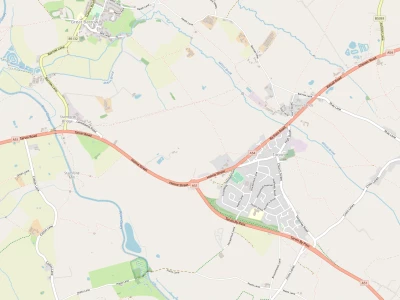I am long-enough in the tooth to remember when, in the 1950's, the Andrew's Sisters sang "I'll be with you in apple-blossom time". Clearly, apple-blossom time is considered to be something quite special. The apple trees in the woodland usually make a good show with their blossom in late Spring but, occasionally, circumstances combine to give a year when the blossom is quite spectacular. It seems that this is such a year.
The woodland "orchard" which is growing behind Crossfields has been established for too short a time (only 5 or 6 years) for our fruit trees to be of any substantial size but, none-the-less, the apple trees carry sufficient blossom for them to be eye-catching. However, just a little further along the path, on the way towards Townfield Lane, there is a really large apple tree that, this year, has been smothered in blossom! Here's another spectacle that our woodland has presented us with this spring. Interestingly, this tree seems to do this in alternate years and then have every other year off – this is technically described as being 'biennial bearing' and can also happen with some of our orchard apples.
This tree itself is a bit of a puzzle. It is clearly a good deal older than our other apple trees and, from its size, is more likely to date back to shortly after the farmers' fields were purchased to allow the building of the A51 Tarvin Bypass. Following the construction of the carriageway, landscaping work was carried out to give some sound mitigation to the village houses and, as a part of this, tree planting was undertaken. It is this planting which has resulted in the high density of trees at the top of the embankment above the road. However, no planting was undertaken as far away from the road as is this apple tree – and, perhaps more importantly – apple trees were NOT included in the mix of trees used on road margins.
Soon after the fields had been abandoned and left to fend for themselves, dog walkers began to use them as a part of their walks around the village. I have a suspicion that one of those walkers in the early days might have been eating an apple and afterwards threw away the core – complete with its seeds. Because the land was, at that time, unmanaged and unloved, none of the mowing undertaken in the woodland today would have happened and the germinating seed would therefore have had a chance to grow into a bush and then a tree without any interference.
But what sort of apple tree is it? If you have ever taken notice of the apples, they are quite small, green and not at all sweet – very unlike like the varieties that we grow in our gardens or in the woodland 'orchard'. The trees we choose to grow are grafted onto another apple tree's roots, so that we will get really good apples like those of the parent plant that supplied the graft. Because the tree we are discussing has been grown from a seed, it is correctly called a seedling and will have a mixture of the characteristics of its two parents. Sometimes the mixing works – think of that superb cooking apple, Bramley's Seedling – but very often the mixing will result in apples which are, at best, indifferent. That is so in our case. There may be lots of blossom and will probably be lots and lots of little apples, but no-one will bother to pick them. Strictly, they are not crab apples but will serve exactly the same function in our woodland – they will supply winter food for creatures when other food is scarce. I remember on a particularly cold day three or four years ago, when all of the apples had been blown down in a January gale, I stood and watched eight(!) blackbirds feasting on the windfall apples. We may not have wanted them – but the blackbirds did!
In the meanwhile, lets enjoy yet another natural spectacle with which our woodland supplies us. This year, that apple tree has been truly spectacular!
Ed: Hopefully the Bank Holiday rain and wind will not have removed all the blossom.
Quick Links
Get In Touch
TarvinOnline is powered by our active community.
Please send us your news and views.








